
Star Raiders is a space combat simulator video game created by Doug Neubauer and published in 1980 by Atari, Inc. Originally released for the Atari 400/800 computers, Star Raiders was later ported to the Atari 2600, Atari 5200, and Atari ST. The player assumes the role of a starship fighter pilot, who must protect starbases from invading forces called Zylons. Piloting and combat are shown in the 3D cockpit view, while a 2D galactic map shows the state of the Zylon invasion. Neubauer made the game during in his spare time at Atari, inspired by contemporary media such as Battlestar Galactica and Star Wars, as well as the 1971 mainframe game Star Trek.

Solaris is a space combat video game for the Atari 2600 published in 1986 by Atari. The game involves a player seeking out the planet Solaris via their starship. To accomplish this, the player must navigate the galactic scanner to explore quadrants of a map. Doing so allows them to explore Federation planets to refuel their ship, and engage in combat with hostile aliens known as the Zylons.

Pitfall! is a video game developed by David Crane for the Atari 2600 and released in 1982 by Activision. The player controls Pitfall Harry, who has a time limit of 20 minutes to seek treasure in a jungle. The game world is populated by enemies and hazards that variously cause the player to lose lives or points.
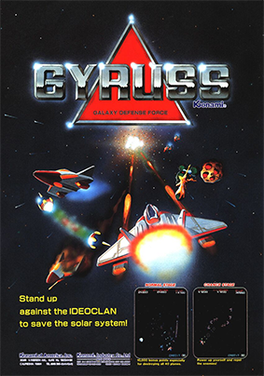
Gyruss is shoot 'em up arcade video game designed by Yoshiki Okamoto and released by Konami in 1983. Gyruss was initially licensed to Centuri in the United States for dedicated machines, before Konami released their own self-distributed conversion kits for the game. Parker Brothers released contemporary ports for home systems. An enhanced version for the Family Computer Disk System was released in 1988, which was released to the North American Nintendo Entertainment System in early 1989.
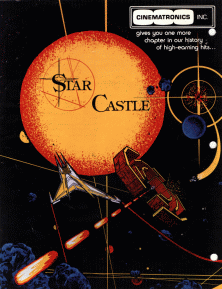
Star Castle is a vector graphics multidirectional shooter released in arcades by Cinematronics in 1980. The game involves obliterating a series of defenses orbiting a stationary turret in the center of the screen. The display is black and white with the colors of the rings and screen provided by a transparent plastic screen overlay.
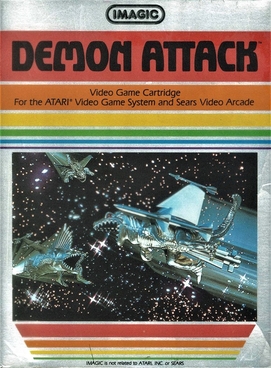
Demon Attack is a fixed shooter video game created by Rob Fulop for the Atari 2600 and published by Imagic in 1982. The game involves the player controlling a laser cannon from the surface of a planet, shooting winged demons that fly down and attack the player in different sets of patterns.

The TV Boy, and its successors TV Boy II and Super TV Boy, are handheld TV games sold by many different companies, including Systema, Akor, and NICS, based upon an unlicensed clone of Atari 2600 hardware. They were released around 1992 and three years later, an improved version of the TV Boy 2, the Super TV Boy, was also made by Akor. They were widely available across Europe. In the UK, they were most visibly available through Argos.
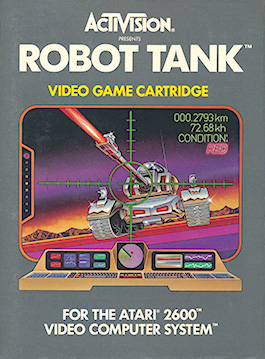
Robot Tank is a first-person shoot 'em up written by Alan Miller for the Atari 2600 and published by Activision in 1983. It is similar in design to Atari, Inc.'s Battlezone tank combat arcade video game and more so to its 2600 port. Robot Tank adds different systems which can individually be damaged—instead of the vehicle always exploding upon being shot—and weather effects.

H.E.R.O. is a video game designed by John Van Ryzin and published by Activision for the Atari 2600 in March 1984. It was ported to the Apple II, Atari 5200, Atari 8-bit computers, ColecoVision, Commodore 64, MSX, and ZX Spectrum.

Chopper Command is a horizontally scrolling shooter released by Activision for the Atari 2600 in June 1982. It was written by Bob Whitehead. The player flies a helicopter left and right over a scrolling, wraparound landscape, shooting down enemy airplanes to protect a convoy of trucks below.
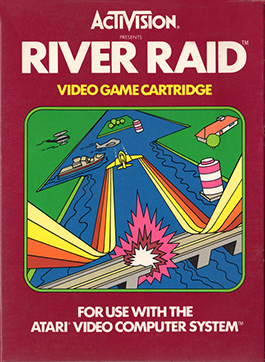
River Raid is a video game developed by Carol Shaw for the Atari Video Computer System and released in 1982 by Activision. The player controls a fighter jet over the River of No Return in a raid behind enemy lines. The goal is to navigate the flight by destroying enemy tankers, helicopters, fuel depots and bridges without running out of fuel or crashing.
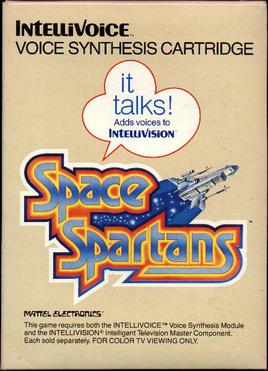
Space Spartans is a space combat simulator video game released for Intellivision, initially programmed by Brian Dougherty, and completed by William C. Fisher and Steve Roney. It is first game which supported the Intellivoice voice synthesis module. Space Spartans is heavily based on Star Raiders, a game released in 1980 for the Atari 8-bit computers.

Star Raiders II is a space combat simulator released in 1986 for Atari 8-bit computers as a sequel to 1979's Star Raiders, which was the killer app for the system. The game was originally developed as part of a tie-in with the movie The Last Starfighter, which featured an arcade game of the same name as part of its plotline. Versions for the Atari 5200 and the Atari 8-bit computers were developed in 1984, although those were never released. Later the tie-in was dropped, and the game converted into a sequel to Star Raiders by changing a number of gameplay elements. The gameplay remained different from the original Star Raiders.

Star Trek: Strategic Operations Simulator is a space combat simulation arcade video game based on the original Star Trek television program and movie series, and released by Sega in 1983. Star Trek uses color vector graphics for both a 2D display and a 3D first-person perspective. The player controls the Starship Enterprise and must defend sectors from invading Klingon ships. The game includes synthesized speech

Beamrider is a fixed shooter written for the Intellivision by David Rolfe and published by Activision in 1983. The game was ported to the Atari 2600, Atari 5200, Atari 8-bit computers, ColecoVision, Commodore 64, ZX Spectrum, and MSX.

Megamania is a fixed shooter video game developed by Steve Cartwright for the Atari 2600. It was published by Activision in 1982. A pilot of an intergalactic space cruiser has a nightmare where his ship is being attacked by food and household objects. Using the missile launcher from their space cruiser, the pilot fends of the attackers. The game was later released for the Atari 5200 and Atari 8-bit computers.

Laser Blast is a single-player video game developed and published by Activision in March 1981 for the Atari VCS console. Designed by David Crane, one of Activision's co-founders, Laser Blast places players in control of flying saucers attacking land targets.

Star Strike is a single-player video game, released by Mattel for its Intellivision video game system in 1981. The Intellivision's best-selling game in 1982, with over 800,000 copies sold, Star Strike was inspired by the attack on the Death Star in the 1977 film Star Wars. The player must drop bombs on alien weapons silos before Earth moves into range.

Oystron is an action game developed for the Atari 2600 by Piero Cavina and released in 1997. It is one of the earliest hobbyist-written games for the console. The game, Cavina's first, was initially made available as a freeware 4 KB binary file designed for use on the Starpath Supercharger and with Atari 2600 emulators. It was later released in cartridge form by XYPE, a group of Atari 2600 homebrew developers.
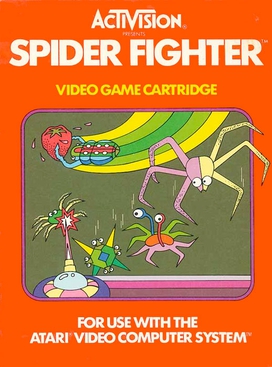
Spider Fighter is a fixed shooter designed by Larry Miller for the Atari 2600 and published by Activision in 1982. The object of Spider Fighter is to protect an orchard containing fruit—grapes, strawberries, oranges, and bananas—from four kinds of bugs. Digital Press described it as "much like the coin-op game Stratovox but w/o the voice."






















